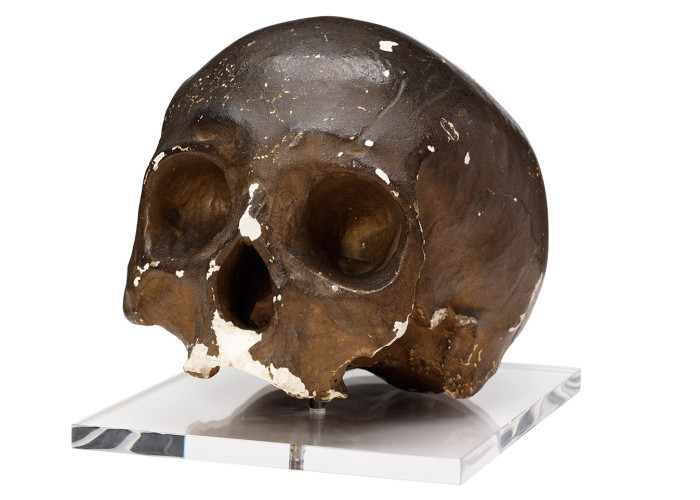Skull of Corporal John Shaw
This is a plaster cast of the skull of boxer and soldier Corporal John Shaw of the 2nd Life Guards. At just over six foot and weighing almost fifteen stone, Shaw was an imposing figure. This Napoleonic Hercules fought with skill both in the ring and on the battlefield, and was only bested by a swarm of horsemen on the field of Waterloo.
Shaw’s boxing career saw him challenge some of the early 19th century celebrity sportsmen like the African-American Tom ‘the Moot’ Molineaux. Shaw’s skull has little in the way of visible injuries, and this could be attributed to his boxing style, as he was particularly adept at protecting his face from punishment by using his left hamd to cover his retreat from an opponent’s attack.
Like many of his contemporaries Shaw supplemented his income by body modelling for the sculptor Benjamin Haydon. It is reported that during one of these sessions Shaw encountered the writer Sir Walter Scott, who would play a significant role in the destiny of the skull after Waterloo.
Shaw’s first and last taste of action was at Waterloo. Early in the battle his regiment charged a body of French cuirassiers and drove them back until the two units mingled in a confused melee where the strength and skill of the individual soldier was key.
Shaw’s training with the regiment and in the ring meant that he excelled at this form of conflict. Indeed his training with the sabre had made his sword arm ‘strong and flexible as a bar of steel.’ However, Shaw’s size made him an obvious target. Although surrounded by as many as nine cuirassiers, he fought valiantly many of his opponents before his sword snapped. In desperation he used his helmet to defend himself, but in vain. He was unhorsed and left, terribly mauled, to bleed to death on the battlefield.
His body was recovered after the battle and buried near La Haye Sainte. A few years later Sir Walter Scott arranged for the exhumation and return of the remains to Britain. Scott’s fascination with the great man inspired him to retain Shaw’s skull in his library at Abbotsford, where it has remained to this day as a rather macabre memento of a legend among men. This plaster cast was made by Shaw’s comrades, and can be seen in the Household Cavalry Museum.
-
Curatorial info
- Originating Museum: Household Cavalry Museum
- Production Date: c. 1815
- Creator: Sir Walter Scott
- Material: Plaster
- Technique: Plaster cast
-
Use this image
You can download and use the high resolution image for use in a non-profit environment such as a school or college, but please take note of the license type and rights holder information below
- Rights Holder: Copyright the Household Cavalry Museum. Photography Relic Imaging Ltd.
- License Type: Creative Commons
Find it here
This object is in the collection of Household Cavalry Museum







